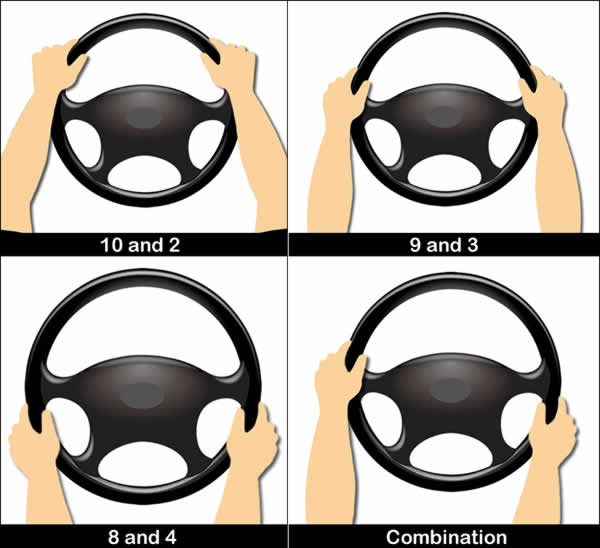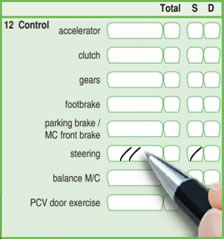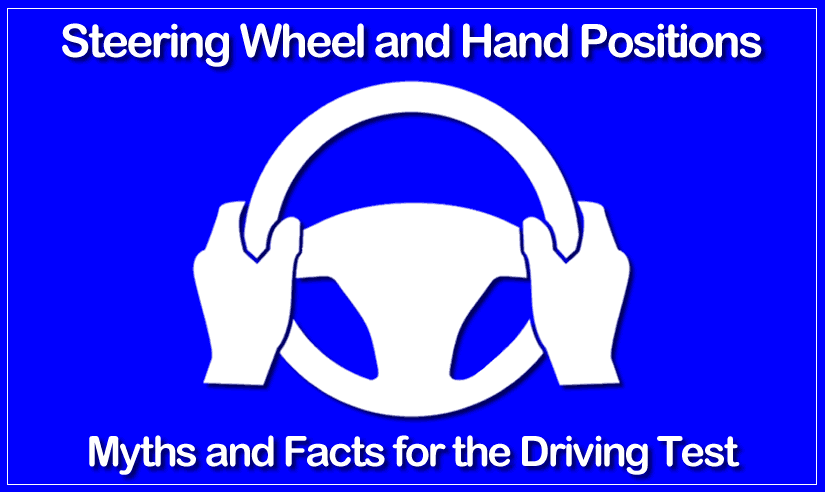When it comes to the practical driving test, there’s often speculation and myths surrounding the use of the steering wheel and hand positions. Here, we’re going to set the record straight and tell you exactly what you can and cannot do when it comes to use of the steering wheel on the driving test.
Can You Fail the Driving Test for Hand Steering Position?
No, you will not fail the driving test for using a non-traditional steering wheel hand position. Of course, you need to be sensible, but within reason, you can hold the steering wheel however you wish, provided that you are in full control of the car.

Most learner drivers / driving test candidates choose to use one of the traditional hand positions. If you think of a traditional clock face, with your hand positions representing the minute and hour hands, those hand positions are: 10 and 2, 9 and 3, 8 and 4, or if you wish, you can have a combination of all three. Choose whichever style is most comfortable for you.
Do You Have to Keep Two Hands on the Steering Wheel at all Times?
It’s not always possible to keep both hands on the steering wheel. If driving a manual, you’ll need to change gear, occasionally you may also need to change gears in an automatic, if for instance you’re driving up or down a steep hill. Additionally, you’ll often need to switch on certain functions such as demisters and light switches. Therefore by law, you must keep one hand on the steering wheel at all times.
To maintain the best possible control of your vehicle, it does of course make sense to keep both hands on the steering wheel when possible. Although in terms of hand placement on the steering wheel, examiners are much more relaxed than they once were, they still expect you to keep both hands on the wheel, if possible.
Can You Fail the Driving Test for Crossing Your Hands
Years ago, crossing your hands was a test failure. These days you can cross your hands while turning the wheel without fear of failing. However, if crossing your hands results in a loss of control, then it could result in problems. To avoid any potential control issues, it’s often best to adopt the push and pull steering method.
Can You Let the Steering Wheel Slide Through Your Hands?
When we turn the steering wheel when traveling round a corner, letting go of the steering wheel will see it automatically spin back to its centre position. This steering self-centring action occurs due to the caster angle and the vehicle’s own weight.
When it comes to steering and the driving test, it’s all about control of the vehicle. Whilst letting the steering wheel slide, or spin through your hands isn’t a test failure in itself, consistently doing so significantly increases the risk of control issues and therefore the risk of driver faults will also increase. Rather than allowing the steering wheel to self-centre and slide through your hands, it’s best to use the push and pull steering method.

What is a Steering Fault on a Driving Test?
On the driving test report, a steering fault will be recorded under section: 12 (control), then under the category of ‘steering’. In the longer box, the examiner has the option of recording a ‘minor’ fault and under the ‘S’ and ‘D’ boxes, a serious or dangerous fault.
Both a serious or dangerous fault results in a test failure and if enough minor faults are accumulated within the same category, this can also result in a test failure. Faults associated with steering are due to a lack, or loss of control rather than the test candidates steering technique or hand placement.

Can you Fail Your Driving Test on Steering?
Yes, failing a driving test under the category of steering will be due to a lack, or loss of control and is the third most common reason for failing a driving test. In relation to steering, driving test are most frequently failed for the following reasons:
- Not steering enough when turning left
- Steering too late when turning left
- Steering around bends
- Steering too late when making a right turn
- Hitting the kerb / mounting pavements
- Passing parked cars
